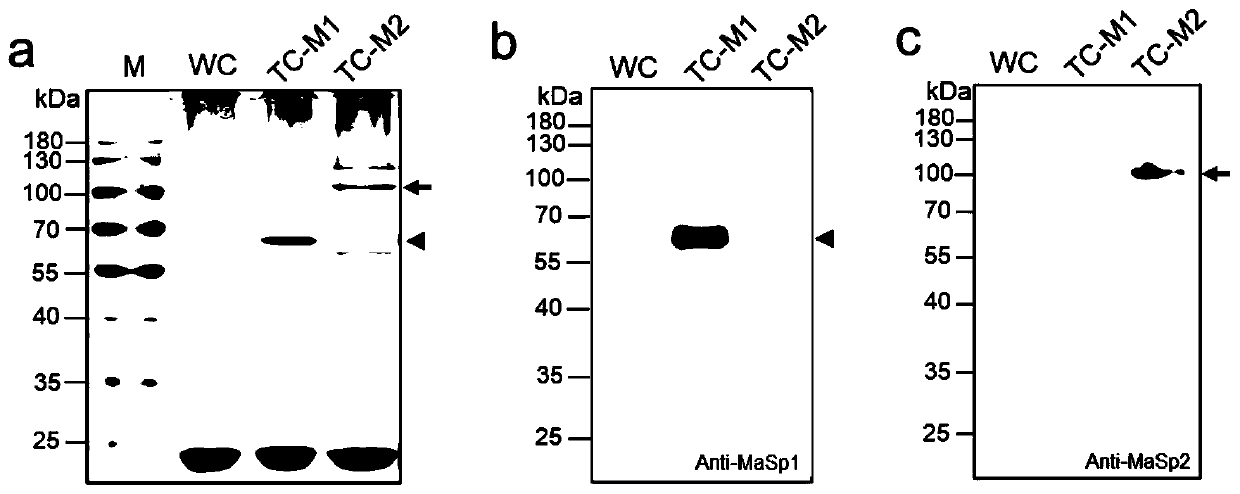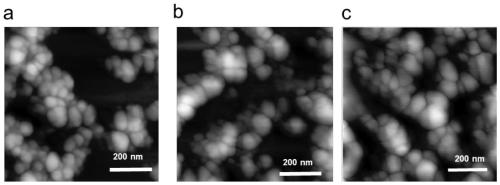Spider MaSps gene and application of spider MaSps gene in preparation of drug-loaded nanoparticles
A gene and spider technology, which is applied to the spider MaSps gene and its application in the preparation of drug-carrying nanoparticles, can solve the problems such as the controlled release of transgenic improved silk drugs and the research report on promoting cell endocytosis, etc. Controlled release ability, improved cell internalization efficiency, and obvious therapeutic effect
- Summary
- Abstract
- Description
- Claims
- Application Information
AI Technical Summary
Problems solved by technology
Method used
Image
Examples
Embodiment 1
[0062] 1. Optimization and construction of artificially designed and modified spider MaSps gene sequence;
[0063] According to the codon preference of the endogenous gene expression sequence in the silkworm genome sequence data, the present invention refers to the black widow spider (Latrodectus hesperus) towed silk protein gene sequence to optimize the design, and Shanghai Shenggong Company synthesized the MaSp1 unit nucleotide sequence (as shown in the 1st-105th position of SEQ ID NO.1) and the MaSp2 unit nucleotide sequence (as shown in the 1st-75th position of SEQID NO.3) and were respectively constructed in the pUC57-T-Simple vector (Shanghai Sangon) became pUC-MaSp1 unit and pUC-MaSp2 unit plasmids. Then, using the XbaI restriction site upstream and the NheI restriction site downstream of the MaSps unit (MaSp1 unit or MaSp2 unit) sequence respectively, the MaSp1 unit was repeated 12 times in series with the XbaI / NheI homologous enzyme to obtain the pUC-MaSp1 plasmid , ...
Embodiment 2
[0067] 1. Preparation of silkworm with transgenic spider MaSps gene
[0068] The commercial diapause silkworm strain 302 (preserved by the State Key Laboratory of Silkworm Genome Biology, Southwest University) was used as the original material, and the parental silkworm eggs were treated with low-temperature catalysis at 16°C to relieve the diapause of the offspring silkworm eggs; 400ng / μL (w / v) mixture of recombinant vector pBac{3×P3-DsRed; Fib-H-MaSp1-LBS} and auxiliary plasmid pHA3PIG (preserved by the State Key Laboratory of Silkworm Genome Biology, Southwest University) (1: 1, v / v) Injected into 207 G0 generation silkworm eggs released from diapause, sealed with non-toxic glue and placed in an environment of 25°C and 85% relative humidity to accelerate green incubation, and hatched to obtain 84 G0 generation ants Silkworms were raised with mulberry leaves until they turned into moths, and 25 G0 generation silkworm moths were obtained, and 15 rounds of G1 generation silkwo...
Embodiment 3
[0073] The steps for preparing silk fibroin drug-loaded nanoparticles using the WC, TC-M1 and TC-M2 protein samples obtained in Example 2 above are as follows:
[0074] 1) After the transgenic silkworm cocoon TC-M1 (or TC-M2) in Example 2 is degummed with a weak alkaline solution, it is completely dissolved in a lithium bromide solution, and then dialyzed with deionized water to obtain the transgenic regenerated silk fibroin TSF-M1 (or TSF-M2);
[0075] 2) Dissolving TSF-M1 (or TSF-M2) protein in secondary water and hydrating at room temperature to obtain hydrated TSF-M1 (or TSF-M2) protein;
[0076] 3) Weigh an appropriate amount of camptothecin (CPT), and completely dissolve it in acetone to obtain an acetone solution in which CPT is dissolved (concentration is 0.1 mg / ml);
[0077] 4) Add the hydrated regenerated silk fibroin obtained in step (2) dropwise to the acetone solution dissolved in CPT obtained in step (3) under vortex conditions, at this time the solution becomes...
PUM
| Property | Measurement | Unit |
|---|---|---|
| concentration | aaaaa | aaaaa |
| particle diameter | aaaaa | aaaaa |
| particle diameter | aaaaa | aaaaa |
Abstract
Description
Claims
Application Information
 Login to View More
Login to View More - R&D
- Intellectual Property
- Life Sciences
- Materials
- Tech Scout
- Unparalleled Data Quality
- Higher Quality Content
- 60% Fewer Hallucinations
Browse by: Latest US Patents, China's latest patents, Technical Efficacy Thesaurus, Application Domain, Technology Topic, Popular Technical Reports.
© 2025 PatSnap. All rights reserved.Legal|Privacy policy|Modern Slavery Act Transparency Statement|Sitemap|About US| Contact US: help@patsnap.com



